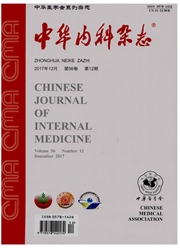

 中文摘要:
中文摘要:
目的观察中国艾滋病患者外周血T淋巴细胞及单核细胞作为HIV—1病毒储存库的情况,了解其在接受48周高效抗逆转录病毒治疗(HAART)中的动态变化及其临床意义。方法35例慢性HIV-1感染的成人在初治HAART的0、24、48周,使用流式细胞仪测定血T淋巴细胞亚群数量,使用磁珠分选法从外周血单个核细胞中分离T淋巴细胞和单核细胞并提取细胞DNA,采用实时荧光定量RT—PCR法检测血清HIVRNA、用SYBRGreen实时PCR对T淋巴细胞和单核细胞内的前病毒HIVDNA载量进行定量测定;使用SPSS18.0软件对收集的数据进行分析。结果35例艾滋病患者在HAART初次启动的0、24、48周,外周血HIVRNA水平分别为(4.12±1.41)、≤1.69、≤1.69lg拷贝/ml,CD4+T淋巴细胞数分别为(196±101)、(321±112)、(392±127)个/μl;在T淋巴细胞中HIVDNA水平分别为(4.03±0.53)、(2.74±1.16)、(2.45±0.41)lg拷贝/106细胞,在单核细胞中HIVDNA水平分别为(2.51±0.68)、(2.16±0.34)、(2.03±0.25)lg拷贝/106细胞。统计学分析显示,在48周HAART过程中,外周血HIVRNA水平与CD4T淋巴细胞数呈负相关,与T淋巴细胞及单核细胞中的前病毒HIVDNA水平均呈正相关;T淋巴细胞中的HIVDNA下降速度慢于单核细胞;外周血CD4+T淋巴细胞与T淋巴细胞前病毒HIVDNA载量呈负相关。结论HIV感染者T淋巴细胞和单核细胞均可作为HIV病毒储存库,而淋巴细胞是更主要的储存库细胞;细胞内HIVDNA水平与血HIVRNA水平变化正相关,与血CD4T淋巴细胞数呈负相关,T淋巴细胞内前病毒HIVDNA水平变化可能作为HAART中AIDS病程进展的观察指标之一。
 英文摘要:
英文摘要:
Objective To observe the dynamic changes of peripheral blood T lymphocytes and monocytes, which serve as HIV-1 viral reservoirs, in Chinese HIV-infected patients receiving highly-active antiretroviral treatment (HAART) for 48 weeks and its clinical significance. Methods A total of 35 chronic HIV-1 infected adults naively received HAART. The peripheral blood T lymphocyte subsets counts were determined by flux cytometry at week 0, 24 and 48. Magnetic activated cell sorting was used to extract cellular DNA from monocytes and T lymphocytes purified from peripheral blood mononuclear ceils. Real-time fluorescent quantitative PCR was used to detect the serum HIV RNA and HIV DNA of monocytes and T lymphocytes. SPSS 18. 0 software was used to analyze the collected data. Results At week 0, 24, and 48 after initiation of HAART, HIV RNA levels of peripheral blood were (4. 12 ±1.41 ), ≤ 1.69, and ≤ 1.69 lg copies/ml, respectively; CD4+ T cells were ( 196 ± 101 ), (321.90 ± 112) and (392 ± 127) cells/p.1, respectively; HIV DNA level in T lymphocytes were (4. 03 ± 0. 53 ), (2. 74 ± 1.16 ) and (2. 45± 0. 41 ) lg copies/106 cells respectively; while in monocytes, HIV DNA levels were (2. 51±0. 68), (2. 16 ±0. 34)and (2. 03 ± 0. 25 )lg copies/106 cells. Statistical analysis revealed that HIV RNA level was negatively correlated with the CD4 T cell count through the whole trail, while positively correlated with the HIV DNA level in blood T lymphoeytes and monocytes. HIV DNA level in T lymphocytes decreased more slowly than HIV DNA in monocytes. Moreover, peripheral blood CD4+ T cell count was negatively associated with the HIV DNA capacity from T lymphocytes. Conclusions Both T lymphocyte and monocyte may serve as viral reservoirs, and T lymphocyte might play a more important role as HIV reservoirs. The blood HIV RNA is correlated positively with the cellular HIV DNA, whereas, CD4+ T cell count is correlated negatively with HIV DNA from lymphocytes, which suggests that H
 同期刊论文项目
同期刊论文项目
 同项目期刊论文
同项目期刊论文
 期刊信息
期刊信息
